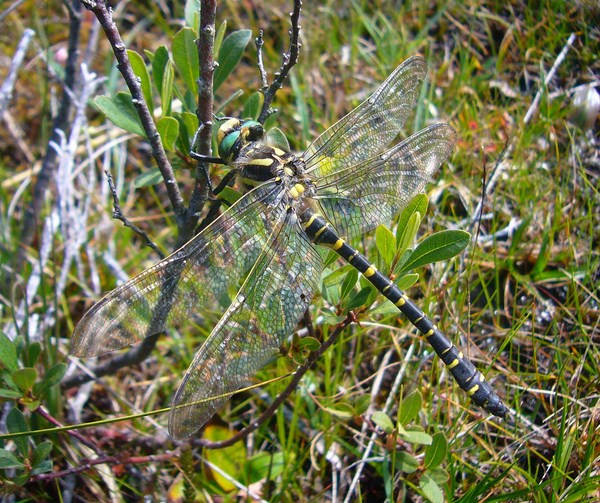This impressive male Golden-ringed Dragonfly was hanging out in a bog near Loch Morar (which incidentally is the deepest freshwater body in the British Isles with a maximum depth of over 1,000ft). Females have a distinctive 'spiked' vulvar scale, diagnostic of the genus, which aids in the oviposition of eggs in streams and ditches. The larvae of this species live for 3-7 years before emerging as adult dragonflies. (c) Richard Brown
Keeled Skimmers were abundant in the same bog, with multiple females egg-laying in the shallow ditches. The smart males, such as this one, were duelling it out over the prime stretches. Keeled Skimmers are common in Southern Europe, but only locally common in Western Britain and Ireland. (c) Richard Brown.
Perhaps the most confiding of all the Dragonflies on the bog was this female Northern Emerald (thanks Andrew!). Although not very visible in this photograph, the two large yellow spots on the third abdominal segment and a broader waist readily separate it from the male of this species. In the UK it is confined to north-west Scotland. (C) Giselle Eagle
Keeping the emerald theme going, this time with a smart male Common Emerald Damselfly that we encountered in another bog on Muck. Males are separated from females by a number of features. Eye colour is blue in males but dark in females. Males show a blue pruinosity (a waxy colouring which develops as the damselfly matures and covers the underlying colouration) which covers all of Segment 2 (which also helps to separate it from the the more southerly Scare Emerald Damselfly), and blue S9/S10 with a distinctively shaped abdomen tip. All Emerald Damselfies share the characteristic 'spread' wings at rest, with all others holding their wings closed. (c) Richard Brown
This probable Highland Darter Sympetrum (striolatum) nigrescens was basking on stones near the bog. Some publications question its validity as a separate species suggesting that it is just a melanistic form of Common Darter S.striolatum. Either way, the lack of yellowish streaks on the femora and the dark sides to the thorax, coupled with large amounts of black around the edges of the eyes and the blackish underside to the abdomen, suggest that this is of the highland form. Interestingly, early odonatologists suggested that Highland Darters were the product of hybridisation of Common Darter and Black Darter and this continues to be a long-standing debate. Recent genetic studies have shown some evidence of isolation from Common Darter, especially on Scottish Islands, resulting in restricted gene flow. It is still suggested, however, that Highland Darter is merely a northern morph of Common Darter. (c) Richard Brown.
And finally a straight-forward, no-nonsense, Large Red Damselfly. Exactly what it says on the tin. (c) Richard Brown.
Keeping the emerald theme going, this time with a smart male Common Emerald Damselfly that we encountered in another bog on Muck. Males are separated from females by a number of features. Eye colour is blue in males but dark in females. Males show a blue pruinosity (a waxy colouring which develops as the damselfly matures and covers the underlying colouration) which covers all of Segment 2 (which also helps to separate it from the the more southerly Scare Emerald Damselfly), and blue S9/S10 with a distinctively shaped abdomen tip. All Emerald Damselfies share the characteristic 'spread' wings at rest, with all others holding their wings closed. (c) Richard Brown
This probable Highland Darter Sympetrum (striolatum) nigrescens was basking on stones near the bog. Some publications question its validity as a separate species suggesting that it is just a melanistic form of Common Darter S.striolatum. Either way, the lack of yellowish streaks on the femora and the dark sides to the thorax, coupled with large amounts of black around the edges of the eyes and the blackish underside to the abdomen, suggest that this is of the highland form. Interestingly, early odonatologists suggested that Highland Darters were the product of hybridisation of Common Darter and Black Darter and this continues to be a long-standing debate. Recent genetic studies have shown some evidence of isolation from Common Darter, especially on Scottish Islands, resulting in restricted gene flow. It is still suggested, however, that Highland Darter is merely a northern morph of Common Darter. (c) Richard Brown.
And finally a straight-forward, no-nonsense, Large Red Damselfly. Exactly what it says on the tin. (c) Richard Brown.






Fantastic photos, well captured.
ReplyDeletePhoto 3 looks like a Northern Emerald. Loch Morar is certainly within the range of Northern Emerald but both Brilliant and Downy Emeralds may also occur there.
ReplyDelete